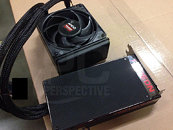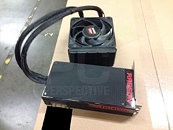Saturday, June 13th 2015

AMD Radeon R9 Fury X Pictured Some More
Here are some of the clearest pictures of AMD's next-generation flagship graphics card, the Radeon R9 Fury X. Much like the R9 295X2, this card features an AIO liquid cooling solution. With the relocation of memory from chips surrounding the GPU to the GPU package as stacked HBM, the resulting PCB space savings translate into a card that's very compact. Under its hood is a full-coverage liquid cooling pump-block, which is plumbed to a thick 120 mm x 120 mm radiator. The card draws power from a pair of 8-pin PCIe power connectors. Display outputs include three DisplayPort 1.2a, and one HDMI 2.0.
Source:
PC Perspective




98 Comments on AMD Radeon R9 Fury X Pictured Some More
Capacity is completely different story, your example tests how fast each GPU reads its complete amount of VRAM.
After all, why pay $450 for a monitor that's future-proof when you can pay $400 for one that isn't, then whine about how it's not your fault on the internet?
Remember when hardware T&L support was revolutionary? :p
In summary: Streaming textures are good but it has a point of diminishing returns that comes around very quickly.
That benign said, my two x290x cards have no trouble with modern games at 2560 x 1600, and by the looks of things two x290x (with 4 GB vram) have no trouble with 4k either source
add in that the Fury will get the texture compression from GCN 1.2 making both the memory bandwidth AND stored memory for textures effectively 40 % bigger (since the compression gives 40 % more memory bandwidth) than the same memory on a GCN 1.1 card, it AMD metrics hold for their compression algorithm.
all in all i thing the memory will be enough in modern games until HMB2 becomes available.
The most tame model is 3000rpm (which I guess is the one they're using), there's also a 4250rpm and 5400rpm models.
Too bad the images are a bit shaky, can't tell whether it's DC or PWM. But on DC the 3000rpm model starts at 4V but it's not really a usable speed (<400rpm) as it's not gonna move pretty much any air at all since the radiator they have must be high FPI.
At 5V it's gonna already spin at ~1250rpm. By 6V it's at 1600rpm.
If it needs that kind of a fan...
We've previously seen it with a low speed D1225C. Now this close to the paper launch with a high speed version? Oh dear.
Yeah sure the H2O 920 fans are crap. I'm not saying the Gentle Typhoon is a shit fan because it's a high speed fan. On the contrary the Gentle Typhoons are great fans on a radiator. Pretty much one of the best.
But since they've swapped to a high speed version of it.. That's what's concerning.
As far as placing the card in the current market, the form factor is definitely OK by today's standards. AMD will easily have the most powerful *short* card on the market, perhaps not the most powerful across the board, but that's something at least. I can definitely see why they went for the AIO solution.
At this point the thing I am most interested in, is how much noise it generates at full load. A single fan is still a single fan solution and as a high speed fan, it may very well top the 290X stock blower which could destroy this card's desirability...
not a secret that a hdd can be a bottleneck and leave you waiting being the reason that the ssd was developed.
I was looking forward to the 390x but it offered me not a dam thing..
Hello Fury, I'll be sure to give you a good home.. Now hurry the f up and bring these out already.
Edit: oh its going to be so fun re-pasting the GPU and hit 4 little buddies ;)
lets say a card has the performance to draw a scene at 50 fps, that is a frame time of 20 ms.
if it has to fetch 1 GB of data from ram a PCI-e 16x bus will take 62 ms. (1GB / 16GB/s = 0,062s = 62ms)
If the drivers are made well and the data allows it the transfer can be done in parallel to the render job, giving a frame time of 62ms and that givers a FPS of 16.1 (1000ms / 62ms/frame = 16.1 fps)
if the GPU is not able to do the parallel work it will take 82 ms for one frame(computing an waiting for data) 1000ms / 82ms/frame = 12,2 FPS.
that being said, some games will load as many textures and models into Vram, and not clean it when its not needed, netting a higher Vram usage than necessary.Remember that a game is more than the graphics, its inteirly possible for the engine or other parts of the game to use the page file without the textures ever getting near the page file.